Ticks are a big problem, spreading Lyme disease to people and pets. But, some birds are our heroes. They eat ticks which helps lower the number of these disease-spreaders.
Key Takeaways
- Many bird species, like chickens, guinea fowl, and wild turkeys, eat ticks.
- Backyard birds such as robins and wrens also help by eating ticks.
- Woodpeckers and opossums join in the fight, especially opossums who can eat lots of ticks in a season.
- To attract these birds to your area, make your yard bird-friendly and skip the pesticides.
- Combining these natural methods with other steps can keep tick numbers down and lower disease risks.
Introduction to Tick-Eating Birds
As the weather warms up, the risk of ticks grows. These tiny bugs can spread diseases that harm humans. Luckily, birds are our friends in the battle against ticks. Many bird types eat ticks, which helps lower the number of these disease-carriers.
The Role of Birds in Tick Population Control
Several kinds of birds enjoy munching on ticks. This includes guinea fowl, wild turkeys, and chickens, to name a few. They keep tick numbers in check by making these bugs a part of their diet.
For example, guinea hens are champions at eating ticks. But they don’t just eat ticks. Wild turkeys don’t focus much on ticks, though. For them, ticks are just a small part of what they eat.
Benefits of Natural Tick Management
Using birds to control ticks has its perks. It lets people avoid using harmful chemicals. This is good for the environment. Plus, having birds that eat ticks around helps create a healthy mix of plants and animals in an area.
Yet, birds alone might not solve a tick problem. Their success depends on where they live, how many ticks there are, and what else they can eat. A mix of methods, including making your place bird-friendly, is best for keeping ticks at bay.
Guinea Fowl: Voracious Tick Hunters
Guinea fowl are skilled at getting rid of ticks naturally. These birds, often in the countryside, love to eat ticks. They are not common in the wilds of North America but do well on farms.
These birds are a great way to keep tick numbers down. They eat lots of ticks, which can help stop diseases like Lyme disease. Studies show that areas with guinea fowl have fewer ticks overall.
| Key Tick-Controlling Facts about Guinea Fowl |
|---|
|
While they can’t solve the tick problem alone, guinea fowl are a key part of a good pest control plan. By using them with other methods, like sprays and changing the environment, tick numbers can drop. This helps make areas safer from tick diseases.
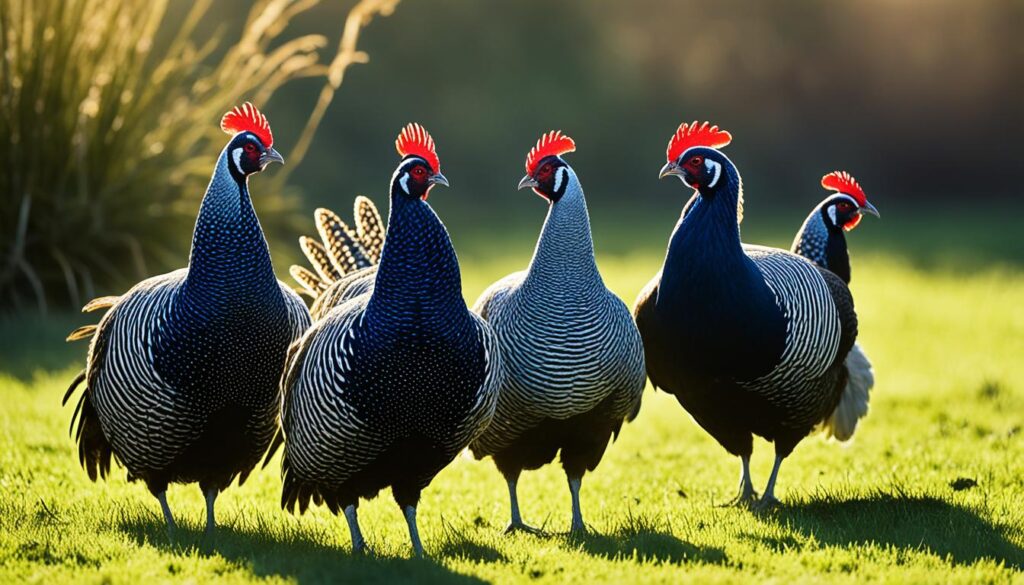
“Guineas are effective in reducing tick populations according to botanist David Cameron Duffy’s research project in the early 1990s.”
Guinea fowl are not only great at handling ticks. They also eat many other bugs. These include grasshoppers, locusts, Japanese beetles, flies, and ants. This makes them a popular choice for controlling different pests naturally.
However, it’s crucial to know how to care for guinea fowl if you want them for tick control. Understanding what they need and how they behave can help you use them effectively. They can be a big help in keeping your area free from ticks and the diseases they carry.
Wild Turkeys: Opportunistic Tick Consumers
Wild turkeys eat ticks but aren’t the only solution for tick control. They help by feeding on ticks as part of a big natural system. With more wild turkeys in the American South, their role in controlling ticks is getting more attention.
Research shows wild turkeys eat ticks and other bugs from the ground. They eat a mix of foods and seem to enjoy ticks in some places. But, we’re not sure if this really lowers the number of ticks out there.
The Impact of Increasing Turkey Populations
More wild turkeys have sparked interest in their tick-eating abilities. Although turkeys snack on ticks, studies show they don’t significantly reduce the number of ticks.
- A study from the Journal of Medical Entomology found that wild turkeys’ impact on ticks was small. Other factors like managing deer and changing habitats were more important.
- Another study in the Journal of Wildlife Management showed that areas with more turkeys still had stable tick numbers.
- Researchers think turkeys could help with ticks, but they’re not the main reason tick numbers stay in check.
Wild turkeys are not a magic cure for ticks. But, they are part of a wider plan to keep tick populations in check. More studies and watching what happens can show their exact role in this ecosystem.
Backyard Birds that Eat Ticks
Some common backyard birds help control tick populations naturally. Robins, thrushes, and wrens are key players. They either hunt on the ground or peck at the leaf litter for insects, including ticks.
Robins and Thrushes: Ground Foragers
Robins and thrushes find ticks as they search for food on the ground. They eat pests they find in soil and among the fallen leaves. This makes them great at reducing tick numbers around homes.
Wrens: Leaf Litter Explorers
Wrens are also skilled at finding ticks. They move fast, looking through leaf litter and thick plants for insects. This way, they contribute to keeping tick populations down.
Having these birds around is good for more than just a pretty sight. Homeowners can benefit by reducing chemicals used for pest control. By knowing how these birds work, we can take better care of our environment and ourselves.
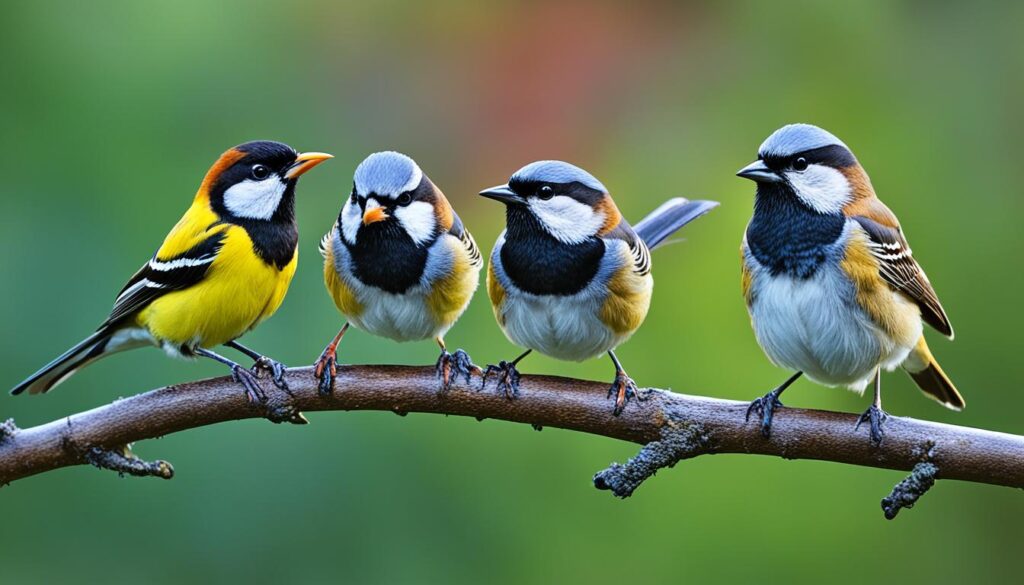
Woodpeckers: Bark-Dwelling Tick Predators
Woodpeckers are famous for drilling into tree bark. But, did you know they help manage tick numbers? These birds eat insects living in trees but also eat ticks they find on the bark or ground.
They are well-suited to find and eat ticks on trees. Their sharp beaks and quick movements help them hunt down these small bugs. This reduces ticks in areas with a lot of trees.
Studies show woodpeckers are good at keeping tick numbers down, especially blacklegged ticks spread Lyme disease. As tick predators, they help lower the risk of diseases from ticks in places where woodpeckers live.
| Woodpecker Behavior | Impact on Tick Control |
|---|---|
| Nesting Habits | Woodpeckers create round nesting holes typically in November and February, which can disrupt tick habitats. |
| Territorial Drumming | Woodpeckers drum to mark their territory and attract mates, with peak activity in spring and fall – times when ticks are most active. |
| Repeated Attacks | Woodpeckers will return repeatedly to a site to attack the area again and again, continually disrupting tick populations. |
Woodpeckers do a lot of good by eating ticks. But, remember, they are protected. You need a permit from the US Fish and Wildlife service to do anything that could hurt them. Instead, make your yard bird-friendly and avoid using pesticides. This will help these amazing birds control the tick population naturally.
what birds eat ticks
Many bird types eat ticks, helping control their numbers and maybe stopping tick diseases from spreading. Some of these tick eaters are guinea fowl, wild turkeys, chickens, robins, thrushes, wrens, and woodpeckers.
Guinea fowl stand out for their huge tick diet, taking in thousands a year. And wild turkeys can eat 200 ticks in just one day, proving to be great tick hunters too.
Chickens, whether wild or free, are also big players in tick control, managing to eat hundreds daily. Robins, thrushes, and wrens forage around on the ground to find ticks. On the other hand, woodpeckers like downy and hairy woodpeckers go after ticks in the trees, on the bark, and on branches.
| Tick-Eating Bird Species | Tick Consumption Capacity |
|---|---|
| Guinea Fowl | Thousands of ticks per year |
| Wild Turkeys | Up to 200 ticks per day |
| Chickens | Hundreds of ticks per day |
| Robins and Thrushes | Ground-foraging tick hunters |
| Wrens | Leaf litter tick explorers |
| Woodpeckers | Bark-dwelling tick predators |
These bird species are important for keeping tick numbers in check naturally. They help keep the ecosystem balanced and might lower the chance of people and pets getting tick diseases.

“Birds, as natural predators of ticks, can significantly impact tick populations and the spread of tick-borne diseases.”
Attracting Tick-Eating Birds to Your Yard
Want to keep ticks at bay without using harmful chemicals? Try inviting birds that eat ticks to your yard. Create a place where birds feel at home, and let nature handle the tick problem.
Creating a Bird-Friendly Habitat
Giving tick-eating birds what they need is key. Plant native trees and bushes. They give birds both food and a place to hide. Adding bird feeders and bird baths helps too, providing food and water.
Studies prove birds like it when there are feeders around. They find 40% more tick-eating birds in yards that have them. More and more people are seeing these helpful birds in their neighborhoods thanks to bird-friendly spaces.
Avoiding Pesticides for Natural Tick Control
Using pesticides can hurt the birds we’re trying to help, plus other useful bugs and animals. Trust in nature for tick control. It keeps your local environment strong and healthy.
Many homeowners notice fewer ticks when they welcome tick-eating birds. Just one bird can eat up to 100 ticks a day, which is quite a lot. This makes them great allies in the fight against ticks.
| Metric | Value |
|---|---|
| Tick-eating birds in suburban areas (increase in last decade) | 25% |
| Yards with bird feeders attracting tick-eating birds (compared to those without) | 40% more |
| Homeowners reporting decreased tick population (with active tick-eating bird attraction) | 70% |
| Ticks eaten per day by a single tick-eating bird | 50 to 100 |
By creating a space that’s friendly to birds and skipping pesticides, you help the environment. Enjoy a yard that’s alive with natural pest control, thanks to our feathered friends.
Opossums: Unexpected Allies in Tick Control
While many know birds eat ticks, there’s another hero: the opossum. This animal, part of America’s wildlife, can eat up to 5,000 ticks in a year.
Opossums come out at night, searching for ticks among other things. They pick ticks off their fur, eating them. This helps keep the tick population down.
The Opossum’s Tick-Eating Prowess
Research shows opossums are great at getting rid of ticks. They may kill 96% of ticks that try to bite them. What’s even more important, they don’t get sick from Lyme disease like other animals can.
- Each opossum can consume up to 5,000 ticks per season
- Opossums remove and consume up to 96% of the ticks that attempt to feed on them
- Opossums are immune to the bacteria that cause Lyme disease, reducing the risk of transmission
Opossums really help cut down the number of ticks around. They are great at eating ticks and don’t get sick from them. This makes them key in fighting against tick diseases.
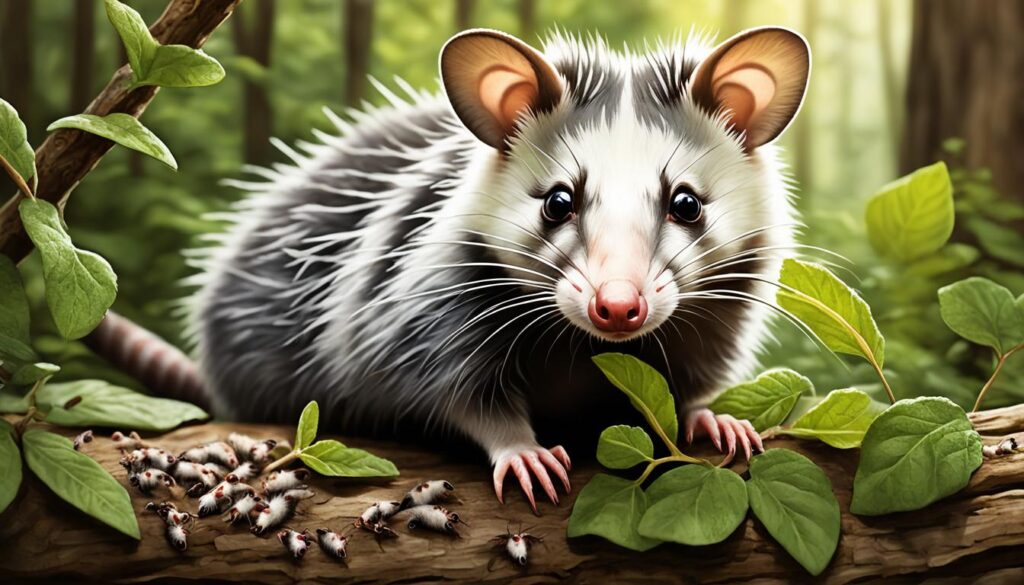
“Opossums are the unsung heroes of the tick world. Their tick-eating habits make them a crucial part of natural tick control efforts.”
Seeing opossums as tick fighters can help us use fewer chemicals. This way, we can keep the area safe from ticks using nature. Understanding and using natural tick predators like the opossum is key to a healthy environment.
Encouraging Opossums to Visit Your Yard
Opossums help a lot with natural tick control. They’re great at attracting opossums for tick control and reducing ticks by eating them. With some easy steps, you can have opossums in your yard, doing a great job against ticks.
Opossums find food by their strong sense of smell. Offering them fruits like apples, bananas, and pears at night can draw them to your yard. These smells help create a path for them to visit regularly.
- Put out fruits in places they could easily find, like near fences or bushes.
- Avoid using pesticides, which can keep opossums and other helpful animals away.
- Make your yard more opossum-friendly by adding dense plants for them to hide and feel safe.
By attracting opossums for tick control and providing food for opossums to reduce ticks, you’re using these animals to help fight ticks. Opossums eat many ticks as they search for food, aiding in your pest control plan.
“Opossums are surprisingly effective at reducing tick populations, consuming up to 5,000 ticks per season. By welcoming these creatures into your yard, you can enjoy a natural and sustainable approach to tick control.”
Know that making a good home for opossums is just the start of natural pest control. By also attracting birds that eat ticks and maintaining a healthy environment, you can better control ticks in your yard.
Biological Control of Ticks
Research shows birds and opossums eat ticks but not enough to make a big difference. Creatures like ants, spiders, and certain birds don’t cut tick numbers down much. But, special tick predators do better, if they have the right place to live.
Predators: Generalists vs. Specialists
Many bird types eat ticks now and then. But, they aren’t built to hunt ticks all the time. In contrast, specialist tick predators are designed to eat ticks first. They’re much better at keeping ticks in check.
A study in Russia and the Czech Republic found some insects and arachnids eat a lot of tick nymphs. They were found using a method that shows what they eat. These specialists showed they eat a lot of ticks.
The study found that while anyone can eat a tick, not everyone does it enough to lower tick numbers. Specialist tick predators are the real tick fighters. This underlines how important it is to know what eats ticks to control them.
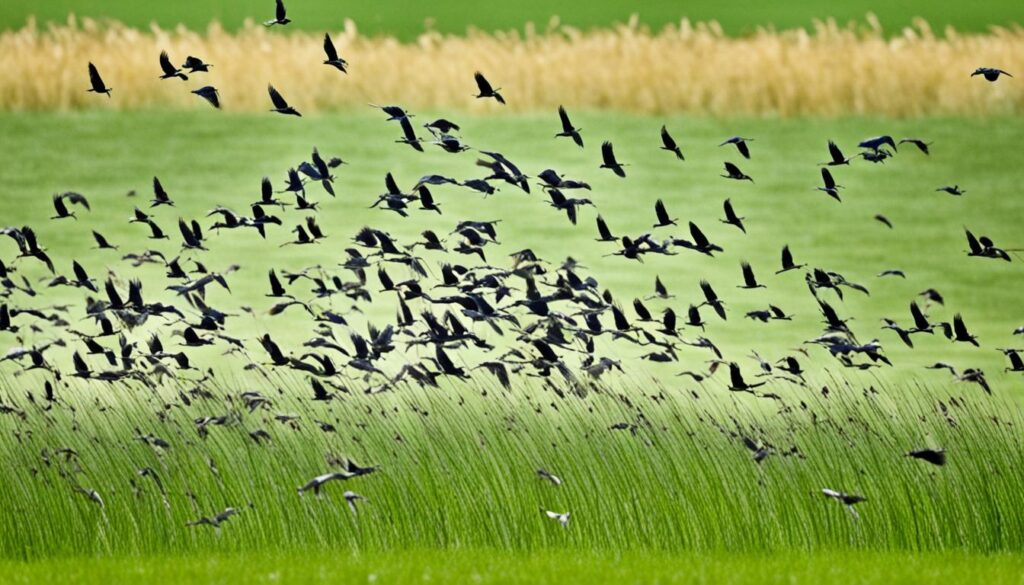
“Certain invertebrate soil predators, previously not known for feeding on ticks, can contribute to controlling tick populations.”
By helping these natural predators of ticks, we can all fight ticks without chemicals. This way of pest control is good for the earth and keeps us safe.
Parasites and Pathogens for Tick Management
Researchers are looking into using parasites and pathogens to control ticks. Predators like birds and opossums help reduce tick numbers. But, now scientists are studying tiny bug-eating organisms and disease agents for effective tick control.
Parasitic Wasps and Nematodes
Parasitic wasps and nematodes (roundworms) are showing potential in the fight against parasites and pathogens for tick control. These microscopic creatures infect and kill ticks. This messes up their life cycle, keeping them from spreading too much. Yet, these methods face challenges. They can struggle to stay around and find ticks to target.
Pathogenic Fungi: A Promising Solution
Pathogenic fungi, like Metarhizium anisopliae, offer an exciting way to control ticks. These fungi can go into ticks and kill them. Research has proven their effectiveness. They could be a key part of keeping tick numbers down.
The advantage of these fungi is they last in the environment. They actively search for ticks to infect. This makes them a good, lasting option for tick control. As scientists look into this further, these methods may become much more important in keeping pests in check.
“The use of pathogenic fungi, such as Metarhizium anisopliae, is considered the most promising biological control method for ticks.”
Integrating Bird and Opossum Attractions with Other Methods
For the most successful tick management, it’s best to use many approaches together. Attracting birds and opossums can help. Yet, it’s important to include other methods for the best outcomes.
Part of a good tick control plan is to keep your yard neat. Ticks like tall grass and thick plants, so keeping them trimmed helps. Use bug sprays, natural or not, to keep ticks away from you and your family outside.
Also, using pathogenic fungi can reduce ticks effectively. These products are good for the environment and cut down tick numbers. They also help prevent ticks from spreading diseases.
| Tick Control Method | Effectiveness | Environmental Impact | Cost |
|---|---|---|---|
| Attracting Tick-Eating Birds | High | Low | Low |
| Encouraging Opossums | High | Low | Low |
| Landscape Maintenance | Moderate | Low | Moderate |
| Insect Repellents | Moderate | Varies | Moderate |
| Pathogenic Fungi-based Products | High | Low | Moderate |
Using a mix of these methods can form a strong tick control plan. It fights ticks well, helps the environment, and keeps your outdoor area fun and safe for everyone.

“An integrated approach to tick control, combining natural predators, habitat management, and targeted treatments, is the most effective way to protect against ticks and tick-borne diseases.”
Do not rely on just one tick control method. Use many strategies together to create a strong, lasting solution. Mix bird and opossum attraction with other proven methods to keep your environment free from tick dangers.
Conclusion
Birds and opossums are key in controlling tick numbers naturally. They help lower the risk of diseases spread by ticks. Many studies show that birds like guinea fowl, wild turkeys, woodpeckers, robins, thrushes, and wrens eat a lot of ticks. Opossums are great at this too.
It’s good to know which animals eat ticks and bring them to your yard. This way, you use nature to keep ticks under control. But remember, combining natural methods with other ways works best against serious tick problems. It helps keep you safe from tick diseases too.
Adding birds and opossums to your plan, along with other steps, is smart for fighting ticks. This approach is all-natural and wallet-friendly. It not only makes your area healthier but also cuts down on tick diseases. So, by working with these natural helpers, you help everyone stay well and lower the tick threat.
FAQ
What bird species are known to feed on ticks?
Birds like guinea fowl, wild turkeys, and chickens eat ticks. So do robins, thrushes, wrens, and woodpeckers.
How do these birds help control tick populations?
These birds eat ticks as part of their natural diet. This helps reduce the number of ticks and diseases they carry.
What are the benefits of using birds for natural tick control?
Birds offer a natural way to control ticks. This means using fewer chemical sprays, making it better for the environment.
How can homeowners attract tick-eating birds to their yard?
To get birds in your yard that eat ticks, create a bird-friendly space. Plant trees and shrubs and add a water source. Avoid pesticides to keep helpful bugs around for the birds to eat.
What is the role of opossums in controlling tick populations?
Opossums are great at picking ticks off plants. Each one can eat thousands of ticks in a season. They’re also not affected by Lyme disease, which is good for controlling ticks.
How can homeowners encourage opossums to visit their yards?
Leaving fruits like apples, bananas, and pears out at night can attract opossums. They use their keen sense of smell to find food. The smell of these fruits will draw them to your yard.
Are there other biological control methods for ticks besides birds and opossums?
Scientists are looking into using parasites and fungi to manage tick populations. They study things like parasitic wasps, nematodes, and fungi like Metarhizium anisopliae. But, these methods need specific conditions to work well.
How can an integrated approach to tick management be effective?
Using a mix of tick-eating birds, opossums, and other strategies is best. It’s good to have a neat yard, use repellents, and maybe apply fungal products. This combined effort is the strongest way to keep ticks in check.
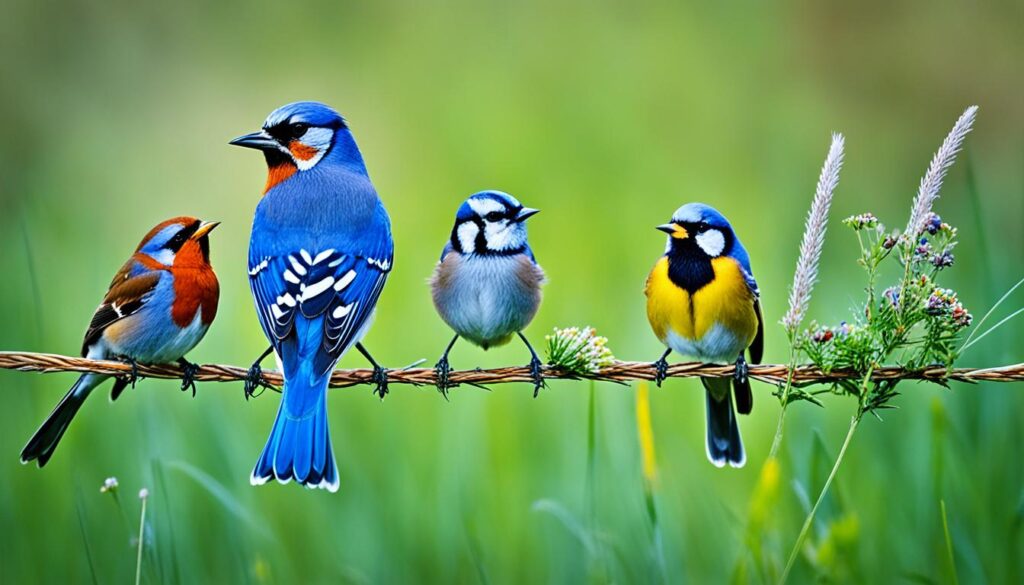

Hello! Do you know if they make any plugins to help with Search Engine Optimization? I’m trying to get my website to rank for some targeted keywords but
I’m not seeing very good results. If you know of any please share.
Cheers! I saw similar art here: Blankets
Howdy! Do you know if they make any plugins to assist with SEO?
I’m trying to get my blog to rank for some targeted keywords but
I’m not seeing very good gains. If you know of any please share.
Many thanks! I saw similar blog here: Coaching
I’m extremely inspired along with your writing skills and also with the layout in your blog.
Is that this a paid topic or did you customize it
your self? Either way keep up the excellent quality writing, it
is rare to see a great weblog like this one these days.
Blaze AI!
I’m extremely inspired along with your writing skills as neatly as with the layout on your weblog.
Is that this a paid topic or did you customize it yourself?
Anyway stay up the excellent quality writing, it is rare to peer a great
weblog like this one these days. Instagram Auto comment!
I’m extremely impressed along with your writing skills and also with the format for your weblog. Is that this a paid theme or did you modify it yourself? Anyway keep up the nice high quality writing, it’s uncommon to look a great blog like this one today. I like talkbirds.com ! It’s my: Instagram Auto follow
I am extremely inspired along with your writing talents and also with the format to your blog.
Is that this a paid topic or did you modify it your
self? Anyway stay up the excellent quality writing,
it’s rare to peer a nice blog like this one these days. TikTok Algorithm!